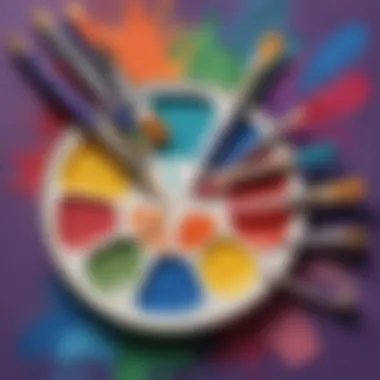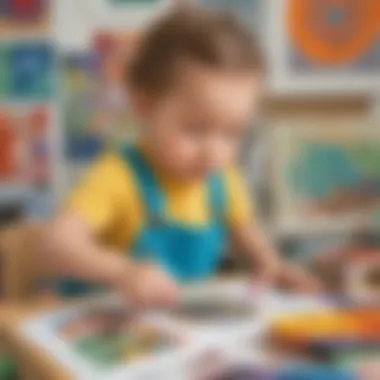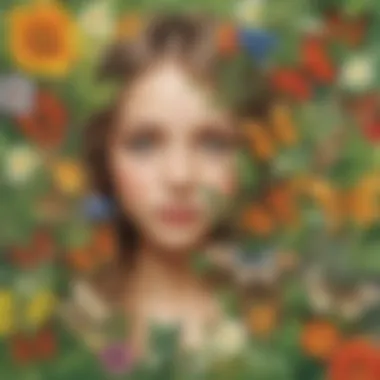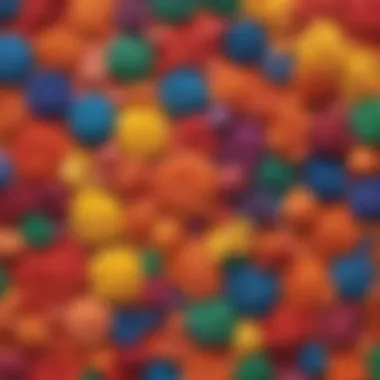Unlocking the Creative Minds of Preschoolers through Art Adventures


Science Fun Facts
Start your journey into the world of creative art activities for preschoolers with some fascinating science fun facts that will pique their curiosity and inspire imagination. Did you know that colors can evoke different emotions in individuals, making them an essential element in artistic expression? Understanding the psychology behind colors can enhance a child's creativity. Additionally, exploring how various textures can be combined in artworks introduces children to the concept of tactile sensations and enhances their sensory experiences.
Discover the Wonders of Art
Dive into the realm of artistic exploration with preschoolers by discovering the wonders of art. Encourage experimentation with different mediums such as paints, crayons, and clay to ignite their creativity. Introduce them to diverse art styles and techniques, from abstract painting to sculpture, providing a broad foundation for artistic expression. Explore how art can convey emotions and tell stories, fostering imagination and narrative skills in young minds.
Engaging Art Activities
Uncover a myriad of engaging art activities that not only entertain but also educate preschoolers. From creating handprint masterpieces to designing imaginative collages, these activities stimulate fine motor skills and hand-eye coordination. Incorporate elements of nature by exploring outdoor art, such as leaf rubbings and rock painting, connecting art to the natural world and nurturing an appreciation for the environment. Encourage children to experiment with a mix of colors, shapes, and patterns to enhance their visual perception and aesthetic sensibilities.
Developing Cognitive Skills Through Art
Explore how engaging in art activities can enhance preschoolers' cognitive development. By encouraging children to make choices during the creative process, such as selecting colors or deciding on composition, art promotes decision-making and problem-solving skills. Introduce sequencing activities like creating step-by-step drawings or arranging story stones to develop logical thinking and storytelling abilities. Through art, children can also express their thoughts and emotions, fostering communication skills and emotional intelligence.
Encouraging Creativity and Self-Expression
Delve into the importance of fostering creativity and self-expression through art in early childhood. Art provides a safe outlet for preschoolers to express their feelings, thoughts, and experiences in a non-verbal manner, promoting emotional awareness and resilience. Celebrate individuality by valuing each child's unique artistic creations, instilling confidence and self-esteem. Encourage open-ended art projects that allow children to explore their creativity freely, inspiring innovation and originality.
Conclusion
Synthesize the rich tapestry of art activities for preschoolers explored in this article, emphasizing the transformative power of creativity and expression in early childhood development. By nurturing a love for art and providing opportunities for imaginative exploration, parents and educators can cultivate a lifelong appreciation for creative expression and critical thinking in young learners.
Introduction
Art activities for preschoolers play a crucial role in their holistic development. Engaging young children in creative endeavors from an early age not only nurtures their artistic abilities but also enhances various cognitive functions. The introduction of creative arts at a young age lays a strong foundation for future academic and personal growth. Preschoolers benefit immensely from exploring different art forms as it stimulates their imagination, improves their fine motor skills, and encourages self-expression through visual mediums. Understanding the significance of incorporating art activities in early childhood education is paramount to fostering a well-rounded individual. This article delves into the diverse aspects of creative art activities suitable for preschoolers, emphasizing the profound impact these activities have on a child's overall development.
Benefits of Art Activities for Preschoolers
Art activities play a crucial role in the holistic development of preschoolers by fostering creativity, fine motor skills, cognitive growth, and emotional expression. For young children, engaging in various art forms not only provides entertainment but also contributes significantly to their cognitive and emotional well-being. These activities offer a multisensory experience that stimulates different areas of the brain, promoting overall cognitive development. Additionally, art allows preschoolers to express their emotions and feelings in a non-verbal manner, aiding in emotional regulation and self-expression. Through the creative process, children learn problem-solving skills, build confidence, and develop a sense of accomplishment, all of which are essential for their overall growth and development.
Enhanced Creativity
Enhanced creativity is one of the primary benefits preschoolers derive from engaging in art activities. By exploring different art mediums, colors, and techniques, children have the opportunity to unleash their imagination and creativity. Through experimentation and self-expression, young artists can develop their unique styles and perspectives, leading to enhanced creative thinking and innovative problem-solving abilities. Moreover, art activities encourage children to think outside the box, fostering a mentality of exploration and originality that can benefit them in various aspects of learning and development.
Fine Motor Skills Development


Participating in art activities such as drawing, coloring, cutting, and pasting helps preschoolers refine their fine motor skills. These activities require hand-eye coordination, precise finger movements, and dexterity, which are essential for tasks like writing, buttoning clothes, and tying shoelaces. By engaging in art, children strengthen the muscles in their hands and fingers, improve hand grip, and enhance spatial awareness. These skills not only contribute to better academic performance but also support overall physical development and coordination. Practicing fine motor activities through art from an early age sets a strong foundation for future learning and skill acquisition.
Cognitive Growth
Art activities stimulate various cognitive functions in preschoolers, including attention, memory, and problem-solving. When children engage in artistic endeavors, they are prompted to observe, analyze, and interpret information visually, which enhances their visual-spatial skills and critical thinking abilities. Furthermore, art promotes sensory exploration, encouraging children to use their senses to explore and understand the world around them. Through visual arts, preschoolers can develop skills in pattern recognition, categorization, and sequencing, all of which are fundamental for cognitive development and academic success.
Emotional Expression
Art serves as a powerful medium for preschoolers to express their emotions and feelings in a safe and constructive manner. By creating art, children can communicate thoughts and emotions that they may find difficult to verbalize. This process not only aids in emotional expression but also promotes self-awareness, empathy, and emotional regulation. Engaging in art activities allows children to channel their feelings creatively, supporting mental health and well-being. Through art, preschoolers can explore their identities, process challenging experiences, and develop coping strategies, fostering resilience and psychological growth.
Choosing the Right Art Supplies
Choosing the right art supplies for preschoolers is a critical aspect of fostering their creativity and development. It plays a pivotal role in enhancing their artistic abilities and providing them with a platform to express themselves artistically. The selection of appropriate art supplies can significantly impact a child's experience and learning outcomes in various art activities. By choosing the right tools and materials, parents and educators can create a conducive environment that facilitates exploration and innovation.
Importance of Selecting Suitable Art Supplies
The importance of selecting suitable art supplies lies in their ability to stimulate a child's imagination and creativity. Different art materials offer unique sensory experiences and challenges, helping children develop their fine motor skills and cognitive abilities. For preschoolers, using the right art supplies can boost their confidence and self-expression, encouraging them to explore their artistic potential without limitations.
Benefits of Quality Art Supplies
Quality art supplies not only ensure a seamless creative process but also contribute to the overall artistic output. By providing children with high-quality paints, paper, canvas, and drawing tools, parents and educators enable them to produce visually appealing artwork. Moreover, good art supplies are safer for young children, minimizing the risk of exposure to harmful chemicals.
Considerations for Choosing Art Supplies
When selecting art supplies for preschoolers, it is essential to consider factors such as non-toxicity, durability, and ease of use. Opting for child-friendly materials that are easy to clean and maintain can simplify the creative process and encourage children to engage in art activities independently. Additionally, choosing a variety of art supplies can broaden children's artistic horizons and inspire them to experiment with different mediums and techniques.
1. Paints
When delving into the world of creative art activities for preschoolers, the topic of paints takes center stage as a fundamental element in nurturing young artistic talents. Paints offer more than just vibrant colors on paper – they serve as a gateway for children to explore their imagination and develop essential skills. Through experimenting with different paint textures, shades, and techniques, preschoolers not only express their creativity but also enhance their fine motor skills and hand-eye coordination. Introducing paints to young children provides a multisensory experience that stimulates their cognitive abilities and encourages sensory exploration.
To ensure a beneficial painting experience for preschoolers, it is crucial to choose non-toxic, washable paints that are safe for young children. Water-based paints are ideal for young artists as they are easy to clean up and pose minimal risk if accidentally ingested. Offering a variety of paintbrush sizes and tools enables children to experiment with different strokes and patterns, fostering their artistic exploration and dexterity. Encouraging children to mix colors, explore blending techniques, and create their unique hues ignites their curiosity and enhances their color recognition skills. Establishing a designated painting area with ample space and protective coverings helps create a safe and inspiring environment for young artists to unleash their creativity.
Incorporating paints into art activities for preschoolers not only cultivates a love for art but also nurtures essential developmental skills. From honing fine motor skills to fostering self-expression and creativity, paints play a pivotal role in stimulating young minds and laying the foundation for a lifelong appreciation of the arts.
2. Paper and Canvas
When we delve deeper into the world of paper and canvas, we uncover a realm of endless possibilities for preschoolers. Paper, with its versatility in texture and weight, allows children to experiment with various art techniques, from delicate pencil sketches to bold watercolor strokes. On the other hand, canvas introduces a tactile dimension to artistic endeavors, offering a sturdy surface for more structured artistic pursuits like acrylic painting or mixed media art projects. By incorporating both paper and canvas into art activities, children engage in a multisensory experience that enhances their artistic skills and hones their ability to express emotions and ideas visually.


Moreover, the tactile nature of paper and canvas plays a crucial role in stimulating a child's sensory perception and spatial awareness. As preschoolers manipulate these materials, whether tearing paper for a collage or stretching canvas for a painting, they develop hand-eye coordination and spatial reasoning. This hands-on engagement with paper and canvas not only refines motor skills but also cultivates an appreciation for texture, color, and form, laying the groundwork for a lifelong affinity towards artistic expression.
In selecting the right paper and canvas for art activities, caregivers and educators must consider the quality, durability, and safety of these materials. Opting for acid-free papers ensures longevity and preserves the vibrancy of a child's artistic creations. When it comes to canvas, selecting materials that are appropriate for the intended art techniques is essential for fostering a positive creative experience. By choosing high-quality paper and canvas, adults can empower preschoolers to explore their artistic potential with confidence and joy, laying a solid foundation for future artistic endeavors.
3. Drawing Tools
In the realm of creative art activities for preschoolers, the selection of appropriate drawing tools holds immense significance. Drawing tools encompass a broad array of items ranging from crayons and colored pencils to markers and chalks. These tools not only serve as instruments for self-expression but also play a pivotal role in enhancing fine motor skills and hand-eye coordination in young children.
When choosing drawing tools for preschoolers, it is crucial to consider factors such as safety, durability, and ease of use. Opting for non-toxic and washable materials ensures a safe and worry-free artistic experience for both children and caregivers. Additionally, selecting tools that are specifically designed for small hands allows for better control and manipulation, aiding in the development of fine motor skills.
The utilization of drawing tools offers preschoolers a valuable outlet for creativity and self-expression. By experimenting with different tools and colors, children can explore their imagination and visually communicate their thoughts and emotions. Moreover, engaging in drawing activities fosters cognitive development, spatial awareness, and visual processing skills, laying a strong foundation for future academic pursuits.
Introducing preschoolers to a diverse range of drawing tools opens up opportunities for them to learn about colors, shapes, and patterns while honing their artistic abilities. Encouraging children to experiment with various techniques and tools promotes problem-solving skills and critical thinking, nurturing their overall cognitive growth and artistic proficiency. By providing access to quality drawing tools and fostering a supportive environment, parents and educators can ignite a lifelong passion for art and creativity in young learners.
Crafting Materials for Creative Art Activities
Crafting materials play a pivotal role in nurturing the creative and cognitive skills of preschoolers through art activities. These materials not only stimulate imagination but also aid in the development of fine motor skills and critical thinking. When choosing crafting materials for preschoolers, it is essential to consider safety, versatility, and ease of use.
Importance of Crafting Materials
Crafting materials encompass a wide array of supplies, including but not limited to colored paper, scissors, glue, beads, sequins, and other embellishments. These materials offer young children the opportunity to explore different textures, colors, and shapes, fostering sensory development and tactile awareness. By engaging with diverse crafting supplies, preschoolers can enhance their hand-eye coordination and dexterity.
Benefits of Crafting Materials
The utilization of crafting materials in art activities encourages creativity, problem-solving, and self-expression in preschoolers. Through the manipulation of materials, children can express their emotions, thoughts, and ideas in a tangible form. Additionally, crafting materials facilitate sensory integration, supporting cognitive growth and perceptual skills.
Considerations for Choosing Crafting Materials
When selecting crafting materials for preschoolers, it is crucial to prioritize non-toxic and child-friendly options to ensure the safety of young participants. Furthermore, opting for materials that allow for open-ended exploration and experimentation can promote autonomy and innovation in art projects. Considering the age and developmental stage of the children is also vital in selecting appropriate supplies that align with their abilities and interests.
Engaging Art Activities for Preschoolers
Art activities are essential for preschoolers as they play a vital role in nurturing creativity and cognitive development. When engaging in art activities, children have the opportunity to explore their imagination, enhance their fine motor skills, and express themselves emotionally. By participating in these activities, preschoolers can develop critical thinking and problem-solving skills while having fun and boosting their confidence.
Finger Painting
Finger painting is a popular and beneficial art activity for preschoolers. This hands-on activity allows children to explore textures, colors, and shapes in a tactile and interactive way. It helps in developing fine motor skills and hand-eye coordination. Finger painting also promotes sensory exploration and creativity in young children. Encouraging preschoolers to finger paint can enhance their self-expression and provide a therapeutic outlet for emotional release.


Collage Making
Collage making is a versatile and engaging art activity that stimulates creativity and improves spatial awareness in preschoolers. By cutting, arranging, and gluing various materials together, children can develop their fine motor skills and visual literacy. Collage making encourages problem-solving skills and fosters an appreciation for art and design. Additionally, this activity allows preschoolers to explore different textures and patterns, promoting sensory development and creative thinking.
Clay Modeling
Clay modeling is a hands-on art activity that aids in sensory exploration and fine motor skill development for preschoolers. Working with clay enhances children's hand strength and coordination while allowing them to mold and shape different forms. Clay modeling encourages creativity and imagination as children sculpt various objects from their imagination. This activity promotes concentration and focus in preschoolers while providing a tactile experience that is both therapeutic and enjoyable.
Nature Art
Nature art involves using natural materials like leaves, twigs, flowers, and stones to create imaginative artworks. This art activity encourages preschoolers to explore the outdoors, appreciate nature, and develop an understanding of their surroundings. By incorporating elements from the environment into their artwork, children can enhance their observation skills and creativity. Nature art promotes environmental awareness, sensory stimulation, and a sense of connection to the natural world.
Recycled Material Crafts
Recycled material crafts involve repurposing everyday items like cardboard, plastic bottles, and egg cartons to create innovative artworks. This art activity teaches preschoolers the importance of sustainability and eco-conscious practices. Engaging in recycled material crafts allows children to develop problem-solving skills, creativity, and resourcefulness. It fosters an appreciation for the environment and encourages them to think critically about waste and recycling.
Tips for Encouraging Creativity
Provide Open-Ended Activities
Introducing preschoolers to open-ended art activities is a strategic approach to fostering creativity. Such tasks encourage children to think outside the box, explore various possibilities, and develop a sense of innovation. By engaging in open-ended projects, little artists can experiment with different materials, colors, and techniques without restrictive guidelines, stimulating their imagination and promoting self-expression.
Offer Praise and Encouragement
Praising and encouraging preschoolers during art activities is fundamental in boosting their confidence and motivation. Positive reinforcement fosters a child's sense of achievement and self-worth, encouraging them to persist in their creative endeavors. Caregivers should focus on praising the effort and creativity rather than the end result, instilling a growth mindset and a love for artistic expression in young minds.
Create a Dedicated Art Space
Establishing a dedicated art space for preschoolers is paramount in fostering a conducive environment for creative exploration. A well-equipped and organized art corner not only provides easy access to art supplies but also signals to children the importance of creativity in their daily routine. Creating a designated art area instills a sense of ownership and inspires children to engage in art activities regularly, fueling their passion for artistic expression.
Allow for Experimentation
Encouraging preschoolers to experiment freely during art activities promotes risk-taking and originality. Allowing children to explore unconventional artistic approaches helps them learn through trial and error, nurturing their problem-solving abilities and critical thinking skills. By embracing a 'learning through experimentation' mindset, caregivers empower preschoolers to discover their creativity and develop a deep appreciation for the artistic process.
Conclusion
One pivotal aspect to underscore in the conclusion is how art transcends mere entertainment for young children; it plays a fundamental role in shaping their cognitive abilities, creativity, and emotional intelligence. By participating in various art activities, preschoolers not only enhance their fine motor skills but also cultivate their problem-solving skills and critical thinking abilities.
Moreover, the conclusion sheds light on the emotional and psychological benefits of art for preschoolers. Through creative expression, children can effectively communicate their feelings, develop a sense of identity, and boost their self-esteem. These aspects are crucial for helping children navigate the complexities of their emotions and build resilience at a young age.
Additionally, the conclusion emphasizes the role of art in sparking curiosity and imagination among preschoolers. By immersing themselves in art projects, children learn to think outside the box, explore different perspectives, and approach challenges with a flexible mindset. This fosters a lifelong love for learning and empowers children to engage with the world in a creative and innovative manner.
Furthermore, the conclusion addresses the practical considerations for parents and educators when incorporating art activities into preschool curricula. Establishing a dedicated art space, providing ample opportunities for open-ended creativity, and offering positive reinforcement and encouragement all contribute to creating a nurturing environment where children can thrive artistically.







